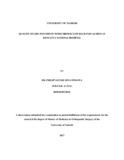| dc.contributor.author | Mwawingwa, Philip G | |
| dc.date.accessioned | 2017-12-14T06:55:26Z | |
| dc.date.available | 2017-12-14T06:55:26Z | |
| dc.date.issued | 2017 | |
| dc.identifier.uri | http://hdl.handle.net/11295/101883 | |
| dc.description.abstract | 1.1 Background:
Chronic low back pain (CLBP) is a very prevalent illness in both developing and developed nations. It is a difficult problem to manage, associated with psychological components, dissatisfaction with work, boredom and generous compensation systems contributing to its existence. Previous studies on CLBP have paid more attention on the psychological components associated with it, associated impact with work and rehabilitation initiatives. No study has been conducted in KNH or locally that seeks to look at the effect that CLBP has on the patient‟s quality of life. The main objective of this study was to describe the pain intensity and identify the health-related quality of life (QOL) of patients with chronic low back pain (CLBP) in KNH.
1.2 Objective:
To determine the Health related quality of life and the pain perceived in patients with chronic low back pain as seen in KNH
1.3 Study design:
Cross-sectional study
1.4 Study setting:
Physiotherapy department and orthopedic clinic in Kenyatta National Hospital
1.5 Methodology:
140 eligible participants, over 18 years of age, meeting the inclusion criteria were consecutively sampled from the physiotherapy department and orthopedic clinic in KNH. Each participant was requested to fill the data collection sheet. Data concerning the socio-demographic aspects, pain perception, parameters of health status and pain severity were recorded in the questionnaire. The SF-12 questionnaire measured the patient‟s perceived quality of life through measuring the physical, mental and social wellbeing of the patient. The differences in the Short form-12 means were compared between the different age groups and genders and CLBP clinical diagnostic types.
xvi
Data from the Data Collection Sheet was then stored in tables and spread sheets of Microsoft Excel. This questionnaire data was entered in SPSS v20 to generate descriptive statistical data, to create presentations in graphic form for reporting, finding relationships between different question responses, and collating open question responses.
1.6 Results:
CLBP was mainly found to affect middle aged patients with a mean age of 46 years. The male to female ratio was 2:3, with an age range of 18 to 82 years. CLBP seemed to affect people in the formal sector (34%) much more than other occupations that patients presented with. Serious specific pathology accounted for 64% of the MRI diagnoses of patients with CLBP in the study followed by Nerve root pathology (25%) and non-specific LBP (11%). The intensity of pain of low back pain was recorded as severe (7 out of 10) in 26.4% of participants, about a quarter of the participants. More than half of the participants rated their general health condition as fair general health condition on the SF-12 item. 5.7% rated their general health condition as poor while 2.1% rated their condition as excellent. | en_US |
| dc.language.iso | en | en_US |
| dc.publisher | University of Nairobi | en_US |
| dc.rights | Attribution-NonCommercial-NoDerivs 3.0 United States | * |
| dc.rights.uri | http://creativecommons.org/licenses/by-nc-nd/3.0/us/ | * |
| dc.subject | Quality of Life in Patients With Chronic Low Back Pain as Seen at Kenyatta National Hospital | en_US |
| dc.title | Quality of Life in Patients With Chronic Low Back Pain as Seen at Kenyatta National Hospital | en_US |
| dc.type | Thesis | en_US |
| dc.description.department | a
Department of Psychiatry, University of Nairobi, ; bDepartment of Mental Health, School of Medicine,
Moi University, Eldoret, Kenya | |



